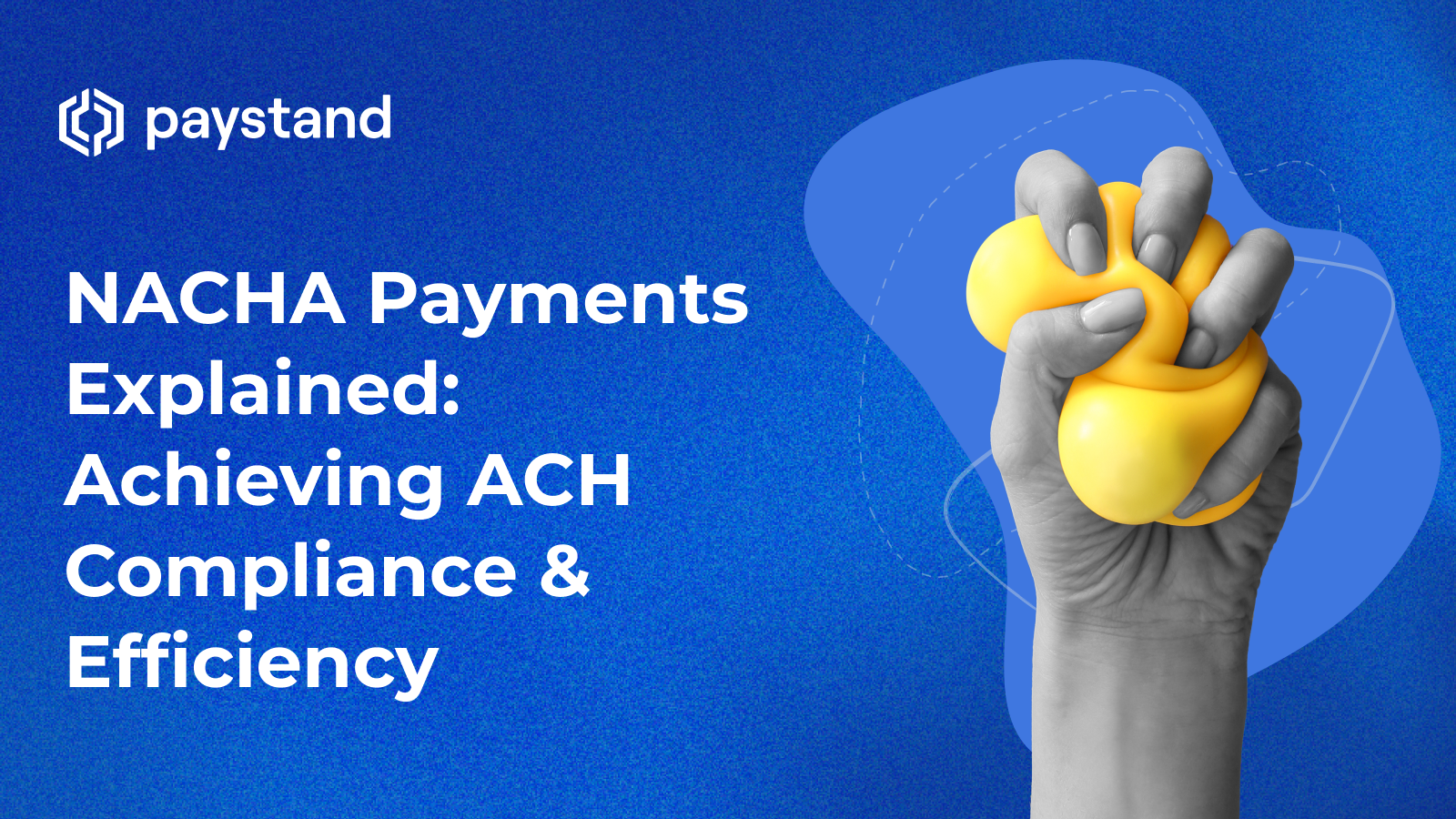NACHA Payments Explained: Achieving ACH Compliance & Efficiency

Table of Contents
- Introduction to ACH Payments
- Defining Nacha Payments
- The ACH Payment Process
- Nacha vs. ACH: Key Differences
- Overview of Nacha Operating Rules
- Formats for Nacha Payments
- Importance of Nacha Compliance
- How Paystand Enhances Nacha Payments
- The Future of Digital Payments with Nacha
Key Takeaways
- Nacha payments, governed by Nacha Operating Rules, are efficient and secure.
- The ACH network ensures cost-effective and seamless electronic transactions.
- Paystand’s integration simplifies ACH payments with automation, compliance, and security.
What Is an ACH Payment?
ACH payments are electronic transfers of funds between bank accounts using the Automated Clearing House (ACH) network. Common ACH payment types include direct deposits, bill payments, and B2B transactions.
How ACH Works:
- A payment originator submits a request.
- The request is sent to the Originating Depository Financial Institution (ODFI).
- The ACH operator processes the transaction and forwards it to the Receiving Depository Financial Institution (RDFI).
- Funds are transferred between accounts, typically within 1–2 business days.
For a more detailed exploration, refer to our article about ACH payments.
What Are Nacha Payments?
Nacha payments refer to electronic payments processed through the ACH network under the governance of Nacha (National Automated Clearing House Association). Nacha oversees the rules and standards that ensure secure and efficient ACH transactions.
Key Features:
- Enable direct deposits, vendor payments, and bill payments.
- Provide secure, low-cost alternatives to checks or wire transfers.
- Governed by Nacha Operating Rules to standardize processes and compliance.
The ACH Payment Process
The ACH payment process involves:
- Payment Initiation: The payer authorizes the transaction.
- Batch Processing: ACH transactions are processed in batches, optimizing efficiency and cost.
- Settlement: Funds are transferred between banks, with notifications sent to both payer and payee.
Types of ACH Payments:
- ACH Credit: The payer initiates the transfer to the payee (e.g., payroll deposits).
- ACH Debit: The payee pulls funds from the payer’s account (e.g., bill payments).
Nacha vs. ACH: Key Differences
| Aspect | ACH | Nacha |
|---|---|---|
| Definition | The electronic network for payments | Governing body for ACH rules |
| Function | Processes fund transfers | Sets operating rules and standards |
| Scope | Transactional network | Compliance, security, and efficiency |
| Focus | Execution of payments | Oversight and rule enforcement |
Example:
While the ACH network facilitates payroll transactions, Nacha ensures these transactions follow specific security and data protection standards.
Understanding Nacha Operating Rules
The Nacha Operating Rules ensure:
- Security: Protecting sensitive banking information.
- Efficiency: Standardizing processes for faster payments.
- Compliance: Adhering to financial regulations and preventing fraud.
Businesses using the ACH network must follow these rules to maintain compliance and avoid penalties.
Nacha Payment Formats
Nacha defines specific payment formats to ensure consistency:
- Standard Entry Class (SEC) Codes: Classify ACH transactions based on type (e.g., PPD for payroll, CCD for corporate transactions).
- Batching and Formatting: Requires precise data structuring for smooth processing.
Paystand ensures compatibility with Nacha formats, streamlining transactions for businesses.
Why Does Nacha Compliance Matter?
Compliance with Nacha rules is critical for:
- Avoiding Penalties: Non-compliance can result in financial and legal repercussions.
- Ensuring Data Security: Protects sensitive payment data from breaches.
- Improving Operational Efficiency: Streamlines ACH payment processes.
How Paystand Enhances Nacha Payments
Paystand integrates directly with the Nacha payment network, offering businesses seamless access to ACH payments while maintaining compliance.
Key Benefits:
- Automation: Eliminate manual processes with automated payment workflows.
- Security: Advanced encryption and compliance with Nacha’s data security requirements.
- Real-Time Payments: Enable faster transactions when needed.
- Cost Savings: Leverage ACH payments to reduce transaction costs.
Case Study:
One client reduced ACH processing times by 30% after adopting Paystand’s automated solutions.
The Future of Digital Payments with Nacha
As businesses increasingly adopt digital payments, Nacha payments remain at the forefront of efficient and secure transactions. With Paystand’s integration, companies can:
- Automate payment processing.
- Ensure security and compliance.
- Tap into the benefits of blockchain-enabled transparency.
Ready to simplify your ACH payments? Discover how Paystand can transform your transactions today.






%20(1)%20(1).jpg?width=100&height=100&name=IMG_3752%20(1)%20(1)%20(1).jpg)